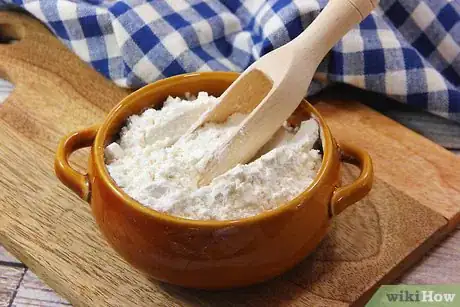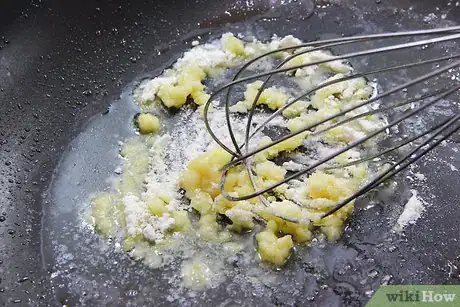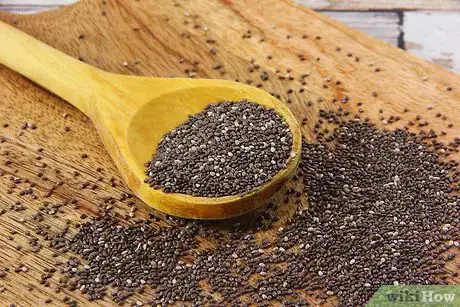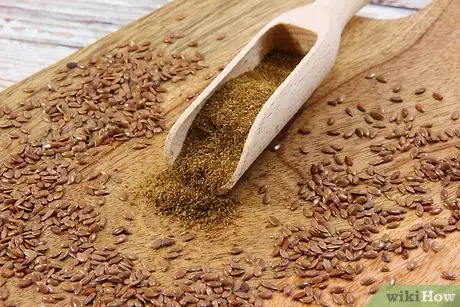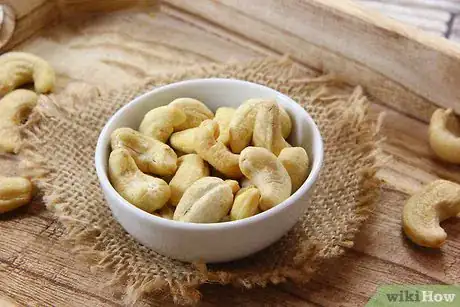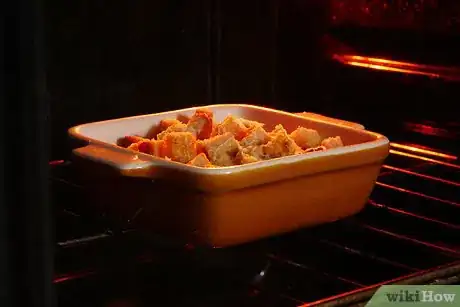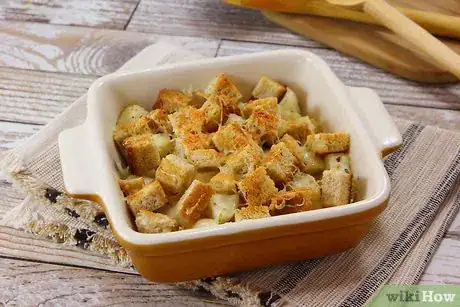This article was co-authored by wikiHow Staff. Our trained team of editors and researchers validate articles for accuracy and comprehensiveness. wikiHow's Content Management Team carefully monitors the work from our editorial staff to ensure that each article is backed by trusted research and meets our high quality standards.
There are 11 references cited in this article, which can be found at the bottom of the page.
This article has been viewed 55,574 times.
Learn more...
A casserole is an easy and delicious dish that's perfect for when you are craving something warm and hearty. Although it's simple to put together and bake in the oven, it can sometimes turn out too liquidy. Thankfully, it's easy to thicken a casserole by adding typical starches, cooking with thickening nuts and seeds, or even just removing the excess liquid.
Steps
Adding Starch
-
1Thicken a meat casserole the most popular way with flour. Add some flour to your pan after you've browned the meat and before adding any liquid. This way, the flour will soak up the juices and fat in the pan. Add about one teaspoon of flour at a time until you get the right thickness.[1]
- You can also add your seasonings to the flour and toss the meat in it before cooking it.
-
2Make a roux. A roux is made with equal parts butter and wheat flour. First, cook the butter over medium heat until thoroughly heated. Slowly add in the flour while whisking. Continue whisking about 2-3 minutes after all the flour has been added. Combine this paste with the base liquid of your casserole before adding it to the casserole dish.Advertisement
-
3Mix up a beurre manié if you don't want to cook your thickener. A beurre manié is similar to a roux except it does not require any cooking. Simply whisk equal parts butter and flour together.[4] Then, roll the thick paste into little teaspoon-sized balls. Add one ball to your casserole at a time, waiting about a minute before adding another one, until you get the right thickness.[5]
- If you make too much beurre manié, you can also freeze the remaining balls and use them later.
-
4Make a cornstarch slurry for a fast and easy thickener. Whisk together equal parts cornstarch and cold water in a small bowl. Use one tablespoon of cornstarch per cup of liquid you would like to thicken.[6] Stir out all the lumps. A few minutes before your casserole is done, add it a little at a time until you are happy with the thickness.[7] Then, let the casserole finish baking.
- You can also substitute chickpea flour for cornstarch. Chickpea flour is an excellent thickener for savory dishes.[8]
-
5Thicken a dairy-free casserole with arrowroot powder. You can also use arrowroot powder instead of cornstarch. Arrowroot starch does not combine well with dairy, but is an extremely effective thickener for dairy-free dishes.[9]
Using Thickening Nuts and Seeds
-
1Use chia seeds for extra nutritional benefits. Chia seeds expand and thicken when added to water. They are also packed with protein, omega-3s, and fiber. Mix 1 tablespoon of chia seeds with 1⁄3 cup (79 ml) water. Wait 15 minutes for the mixture to thicken, then slowly add to the casserole just before it's finished baking in the oven.[10]
- Chia seeds are also rich in vitamins and minerals like magnesium, calcium, phosphorus, and B vitamins.
-
2Add ground flax seeds if you need an extra strong thickener. Flax seed absorbs water quickly and you only need a small amount to make a big difference. Grind the flax seeds in a food processor or coffee grinder and add them little by little directly to the casserole just before it's finished baking. Try adding 1 tablespoon of flaxseed per cup of casserole liquid.[11]
- If you don't want to grind the flax seeds yourself, you can also buy them already ground.
-
3Try raw cashews for a smooth consistency. Cashews are great for thickening vegan recipes because of their creamy consistency. Use ¼ cup of cashews for every cup of casserole liquid.[12] Soak the cashews in water overnight in the refrigerator. Drain the water off and blend in a blender. Then, add them directly to your casserole broth before baking.[13]
- If you are pressed for time and can't soak the cashews overnight, bring a pot of water to boil. Remove it from the heat and soak your cashews in the water for half an hour.[14]
Removing Excess Liquid
-
1Strain the liquid from the casserole after cooking. If you have a lot of liquidy broth in your casserole, you can gently pour it out of the casserole dish after cooking. To do this, put a lid over the casserole dish. Leave a small slit on one side and pick up the dish with oven mitts. Gently pour the liquid through the slit, trying not to disturb the other elements in the casserole.
- You don't necessarily have to get rid of the extra liquid. Try pouring it into a pot and simmer on medium heat until it reduces and thickens. You can then add it back to the casserole.[15]
-
2Leave it in the oven longer if there's only a little extra liquid. Sometimes the best way to thicken a casserole is to simply let the heat of the oven do the work. If you think it only needs to a little extra thickening, leave it in the oven for an extra 5-10 minutes.[16]
- Check with the other ingredients in your casserole to make sure you can cook it a little longer. You don't want the top of the casserole to burn or the vegetables to get too soft if you leave it in the oven longer.
-
3Let your dish thicken as it cools if you don't plan to eat it right away. Your casserole will naturally thicken as it cools. If you plan to have leftovers, or you are making a casserole that you will refrigerate and eat later, letting it cool may be all you need to get the right thickness.[17]
- If you already have an extra thick casserole that you want save for leftovers, remember to add a little broth or water to it before you store it since it will get even thicker as it cools.
Sample Thickeners
Warnings
- Don't just add flour or cornstarch or other dry goods to a hot casserole. It will not be able to dissolve fully and can make the sauce lumpy.[20]⧼thumbs_response⧽
- Don't estimate the amounts when making a slurry, roux, or beurre manié. Using equal parts butter and flour will give the best consistency to your casserole.[21]⧼thumbs_response⧽
References
- ↑ https://coach.nine.com.au/2018/07/05/13/10/healthy-casserole-recipes
- ↑ https://www.deliaonline.com/how-to-cook/meat/the-principles-of-casserole-cookery
- ↑ https://www.vegetariantimes.com/skills/roux-how-to
- ↑ https://blog.chefworks.com/uniforms/thicken-that-soup-or-sauce-the-right-way/
- ↑ https://www.saveur.com/article/Techniques/saveur-100-beurre-manie
- ↑ https://www.thespruceeats.com/thicken-a-sauce-with-cornstarch-996071
- ↑ https://blog.chefworks.com/uniforms/thicken-that-soup-or-sauce-the-right-way/
- ↑ https://www.thekitchn.com/beyond-socca-5-more-ways-to-use-chickpea-flour-ingredient-spotlight-187659
- ↑ https://www.thespruceeats.com/thicken-a-sauce-with-cornstarch-996071
- ↑ https://www.saveur.com/ch-ch-ch-chia#page-2
- ↑ https://www.healthline.com/nutrition/substitutes-for-cornstarch#section6
- ↑ http://www.onegreenplanet.org/vegan-recipe/creamy-vegan-not-clam-chowder/
- ↑ http://www.onegreenplanet.org/vegan-recipe/creamy-vegan-not-clam-chowder/
- ↑ http://www.onegreenplanet.org/vegan-recipe/creamy-vegan-not-clam-chowder/
- ↑ https://www.deliaonline.com/how-to-cook/meat/the-principles-of-casserole-cookery
- ↑ https://www.onehappyhousewife.com/sweet-potato-casserole-instant-pot/
- ↑ https://blog.chefworks.com/uniforms/thicken-that-soup-or-sauce-the-right-way/
- ↑ https://blog.chefworks.com/uniforms/thicken-that-soup-or-sauce-the-right-way/
- ↑ https://blog.chefworks.com/uniforms/thicken-that-soup-or-sauce-the-right-way/
- ↑ https://blog.chefworks.com/uniforms/thicken-that-soup-or-sauce-the-right-way/
- ↑ https://blog.chefworks.com/uniforms/thicken-that-soup-or-sauce-the-right-way/
